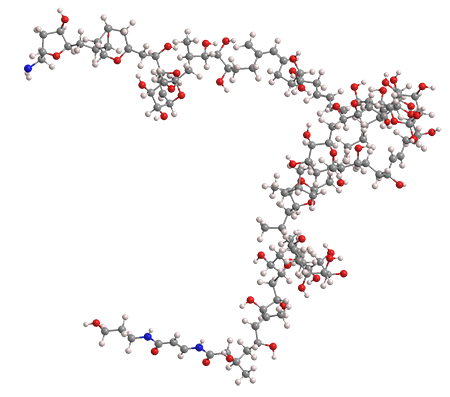What molecule am I?


Palytoxin is a high–molecular mass fatty polyalcohol produced by zoanthid corals of the genus Palythoa. It is one of the most toxic nonprotein compounds known and contains one of the longest carbon chain of all naturally occurring molecules.
In 1971, Richard E. Moore and Paul. J Scheuer at the University of Hawaii (Honolulu) isolated palytoxin from Palythoa toxica, a substance known to native Hawaiians as “limu-make-o-Hana”. The Hawaiian name translates as “seaweed of death from Hana”, but the authors quickly determined that P. toxica is a type of coral, not a seaweed.
Eleven years later, Moore and coauthors at Hawaii and Carnegie-Mellon University (Pittsburgh) published the full structure with absolute stereochemistry. But earlier the same year, Yoshito Kishi, Yoshimasa Hirata, and colleagues at Harvard University, Shizuoka University (Japan), and Meijo University (Nagoya, Japan) published a structure that differed from Moore’s at 11 of the 64 stereocenters.
In 1983, Yuzuru Shimizu at the University of Rhode Island (Kingston) wrote that Kishi and Hirata’s syntheses of palytoxin fragments constituted a superior method to Moore’s high-resolution NMR and thus led to the correct structure. More than a decade later in 1994, Kishi and Edward M. Suh published a total synthesis of palytoxin.
The toxicity of palytoxin (see “Palytoxin hazard information”) has long been known, but a recent report illustrates how the poison can show up in unexpected places. A January article in Chemical and Engineering News described how P. toxica can lurk in home tropical aquariums and poison owners when they clean the rocks and corals in their tanks. Fortunately, warnings of this danger rapidly spread through forums and websites for aquarium hobbyists.
Palytoxin hazard information
| GHS classification*: acute toxicity, oral, category 1, 2 | |
| H300—Fatal if swallowed | |
| GHS classification: acute toxicity, dermal, category 1, 2 | |
| H310—Fatal in contact with skin | |
| GHS classification: acute toxicity, inhalation, category 1, 2 | |
| H330—Fatal if inhaled | |
*Globally Harmonized System of Classification and Labeling of Chemicals. Explanation of pictograms.
Palytoxin fast facts
| CAS Reg. No. | 77734-91-9 |
| Molar mass | 2680.14 g/mol |
| Empirical formula | C129H223N3O54 |
| Appearance | White, amorphous, hygroscopic solid |
| Melting point | 300 ºC (dec.) |
| Water solubility | Very soluble |

Learn more about this molecule from CAS, the most authoritative and comprehensive source for chemical information.
Molecule of the Week needs your suggestions!
If your favorite molecule is not in our archive, please send us a message. The molecule can be notable for its current or historical importance or for any quirky reason. Thank you!
Stay Ahead of the Chemistry Curve
Learn how ACS can help you stay ahead in the world of chemistry.

